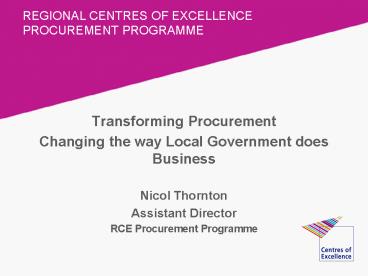Transforming Procurement - PowerPoint PPT Presentation
1 / 22
Title:
Transforming Procurement
Description:
What are the obstacles to optimising savings? Procurement Landscape ... Optimise collaborative procurement. Deliver consistently high quality management information ... – PowerPoint PPT presentation
Number of Views:64
Avg rating:3.0/5.0
Title: Transforming Procurement
1
REGIONAL CENTRES OF EXCELLENCE PROCUREMENT
PROGRAMME
- Transforming Procurement
- Changing the way Local Government does Business
- Nicol Thornton
- Assistant Director
- RCE Procurement Programme
2
Key Drivers
- Local Government White Paper emphasises
collaboration and smarter procurement
- CSR 07. Local Authorities could be facing a cash
saving target of 5 billion
- Citizens expect improving services
3
How Big is the Procurement Business?
- Local Authorities will spend about 100 billion
annually throughout the CSR 07 period
- Over 40 of spend is on contracts with the
private and third sectors
- After schools expenditure is taken into account,
the proportion of spend on third party contracts
is about 60
4
Where does the money go?
5
What is the scope for savings?
- About 12 billion is spent on construction
related goods and services
- The use of regionally based framework
contracts pioneered in the East Midlands and the
South East supported by the RCEs are already
aggregating over 1 billion of construction
related expenditure with predicted savings in the
millions. These arrangements are ripe for
systematic promotion and roll out to all regions
6
What is the scope for savings?
- About 12 billion is spent on construction
related goods and services
- Reverse e auctions for commonly needed
- repairs components and materials for social
housing have resulted in contracts open to the
sector that can save millions.
7
What is the scope for savings?
About 12 billion is spent on commodity goods and
services
- Reverse e auctions supported by the RCEs have
resulted in excellent contracts open to all waste
collection authorities for wheeled bins with a
price reduction of over 30 thanks to the
aggregation of buying power achieved through the
events
- Difficult markets like energy ( almost 1 billion
spend in local government) need to be approached
with top level category expertise in a strategic
way. The RCEs have published a comprehensive
guide to effective procurement in this market.
8
What is the scope for savings?
About 12 billion is spent on commodity goods and
services
- The use of national and regional contracts
avoiding the need for expensive and time
consuming procurement activity at local authority
level can typically save over 5. The North West
RCE has successfully promoted these sorts of
contracts and the RCEs have now established an
open contracts database which will be promoted to
all local authorities in each region.
9
What is the scope for savings?
About 6 billion is spent on care services for
adults and children
- Care costing tools supported by the RCEs are
beginning to result in less variation in price
for expensive care packages but need to be used
universally
- The use of e-procurement tools in paying for
domiciliary - care is producing major savings
- Regional commissioning and contracting models
are - beginning to be explored
10
What is the scope for savings?
- About 3 billion is spent on environmental
services
- Millions can be saved by jointly procuring waste
collection and disposal solutions
- A framework approach is being developed to
- aggregate demand
11
What are the obstacles to optimising savings?
- Procurement Landscape
- Lack of procurement expertise
- Lack of Market Intelligence
- Failure to optimise buying power
- Self imposed rules
- Autonomous behaviour culture
- Lack of capacity to improve resulting in missed
opportunities
12
Non Collaborating Landscape
13
Aggregation via Buying Organisation
14
New Collaborative Arrangements
15
Managed Landscape
16
Why manage the landscape?
- Leverage public sector common spend
- Coordinate approaches to markets
- Optimise collaborative procurement
- Deliver consistently high quality management
information - Deliver against the various policy requirements,
e.g. the sustainability agenda - Engage with suppliers to drive innovation and
shape markets
17
RCE Procurement Programme
- The programme seeks to identify and promote to
local authorities via the 9 RCEs the very best
practice and deal opportunities so that savings
can be optimised - We are beginning to look hard at the link between
our products and services and cash savings at
local level - Creation of Procurement Advisory Groups (PAG) to
deliver guidance and best practice through the
involvement of a cross section of market
specialists
18
(No Transcript)
19
What needs to be done?
- Collecting analysing and using market
intelligence to develop and implement procurement
strategies across authorities and regions
focussing on the big spend areas
- Concentrating procurement expertise in far fewer
highly professional organisations who operate on
behalf of the many
20
What needs to be done?
- Aggregation of buying power in key markets to the
correct level for sustainable value for money
- Procuring contracts that are open to the many
not - not restricted to the few
21
What needs to be done?
- Managing and wherever possible reducing demand
- Entering markets that require moderation
- Rationalising supplier bases
- Deploying e-procurement tools effectively
- Doing these things with partners
22
- Thank you for your attention
- and I look forward to your
- questions at the end of the
- session































